Zoas, Palys - The Zoanthidae Order
Order: Zoanthidea (also known as Zoantharia)
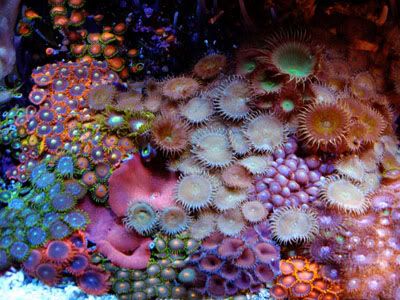
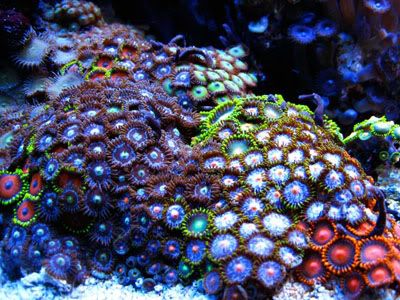
Zoanthids (order Zoantharia also called Zoanthidea or Zoanthiniaria) are an order of cnidarians commonly found in coral reefs, the deep sea and many other marine environments around the world. These animals come in a variety of different colonizing formations and in numerous colors. They can be found as individual polyps, attached by a fleshy stolon or a mat that can be created from small pieces of sediment, sand and rock. The term "zoanthid" refers to all animals within this order Zoantharia, and should not be confused with "Zoanthus", which is one genus within Zoantharia.
They are among the most commonly collected coral in aquaria, easily propagating and being very durable in many water conditions.
Characteristics
Zoanthids can be distinguished from other colonial anthozoans and soft coral by their characteristic of incorporating sand and other small pieces of material into their tissue to help make their structure (except for the family Zoanthidae). The main characteristic of the order is that their tentacles are organised in two distinct rows.
While the most well-known zoanthids are the zooxanthellate genera found in tropical and sub-tropical waters (primarily Zoanthus and Palythoa), many other species and genera exist, some still relatively unknown to science. Many zoanthids (in particular the genera Epizoanthus and Parazoanthus) are often found growing on other marine invertebrates.
Often in zooxanthellate genera such as Zoanthus and Palythoa there are a large number of different morphs of the same or similar species. Such zooxanthellate genera derive a large portion of their energy requirements from symbiotic dinoflagellates of the genus Symbiodinium (zooxanthellae), similar to many corals, anemones, and some other marine invertebrates.
Hardiness
Most are considered easy. Certain varieties prove more difficult, especially blue color morphs.
Flow
Varied tolerance. Wild-caught specimens often need high flow.
Lighting
Varied tolerances. Most will grow under low light, but higher light if acclimatized will effect faster growth. Brighter varieties tend to need more light. Also, brighter varieties that are moved from intense lighting to less intense lighting have a tendency to brown out.
Placement
Varies. Zoanthids will usually grow wherever you put them. A good strategy to keep them from covering your tank in time is put them on a small rock isolated in the sand, as they will not spread over the sand.
Propagation
Easy. Under the right conditions these can grow very fast. Rule number one when fragging Zoanthus is to WEAR GLOVES and GOGGLES. The potential for poisoning from their palytoxin is high if not careful. A little "juice" on a cut, or on your fingers that you wipe your eye or mouth with, and you will feel sick. Also is easy to get squirted in the eye, hence the goggles. The best method is to use a wood chisel to scrape a small amount of rock under the attached polyps and use a razor to seperate them at their stolon. The separate pieces can then be glued to another rock or propagation plug with super glue.
Aggression
Low, but will over-grow other corals if not careful. Note potentially toxic if handled. Zoanthids can sting and significantly damage many SPS corals such as Acropora. If allowed, they can eventually sting and damage Acropora to the point where they can overgrow the base of the hard coral.
Availability
Readily available, although certain varieties can be hard to find.
Predators
Heliacus Snails
Wild zoanthid colonies are commonly collected with a predatory snail called "Heliacus." These snails specialize in eating zoanthids, and should be removed immediately.
Zoanthid-Eating Nudibranchs
Zoanthid colonies can also be afflicted by parasitic nudibranchs (sea slugs). These nudibranchs also contain the palytoxin from the zoanthids, so should be considered poisonous and handled with care.
"Fungus"
Whether or not it truly is a fungus is unclear, but certain Zoanthids, particularly pink Palythoa can get a fungus-like infection. One treatment that works well is to dip the infected colony in a solution of 80% tank water, 20% Hydrogen Peroxide for UP TO 5 minutes. This dip is strong and irritates the colony along with killing the infection, so do not dip the colony too long.
Danger
Some zoanthids contain the highly toxic substance palytoxin. Palytoxin is one of the most toxic organic substances in the world, but there is an ongoing debate over the concentration of this toxin in these animals. However, even in small quantities, the toxin can be fatal should it be ingested or enter the blood stream. If delivered immediately, vasodilators injected into the ventricle of the heart can act as an antidote.
In order for this toxin to be dangerous to humans, the average aquarist would need to ingest the zoanthid in sufficient quantities, or brush a recent cut over it. Average handling, propagation and aquarium maintenance is unlikely to pose any danger beyond a localized skin reaction.
Palytoxin is a tumor promoter, and is being studied in relation to signaling pathways in skin cancer genesis. Contrary to common belief, palytoxin can be absorbed through intact skin. The danger of acute poisoning from venomous zoanthids is quite real. An aquarist was poisoned through skin injuries on fingers by a Parazoanthus species, but recovered after 3 days. His zoanthid was found to contain 2-3 milligram of palytoxin per gram. For comparison, the intravenous LD50 dose of palytoxin for a grown man is less than 8 microgram. Thus each gram of the offending zoanthid contained enough venom to kill at least 125 grown men.
Diet
Zoanthids feed both by photosynthesis, aided by the zooxanthellae they contain, and by capturing plankton and particulate matter. Although photosynthesis aids in their nutrition, even species that do not actively capture plankton cannot live through photosynthesis alone. Zoanthids can eat meaty foods, such as lancefish, brine shrimp, krill and bloodworms.
The Zoanthidae Family
Genus:
Isaurus - Snake Polyps
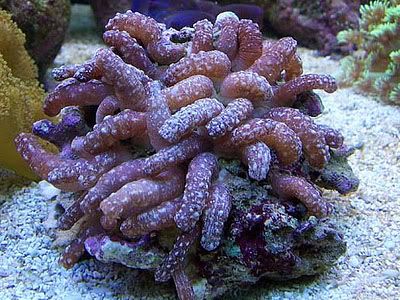
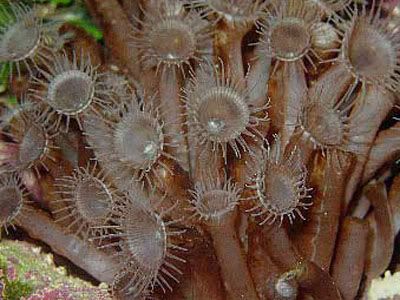
Snake Polyps (Isaurus tuberculatus) are long brown polyps that attach to a hard surface like rockwork. During the day, they look like brown worms that extend from the base. At night, they extend feather-like feeding apparatus into the water to feed on zooplankton like Daphnia, Cyclopeeze, copepods and similar items. They are also photosynthetic and receive must of their nutrition from the algae in their tissues, but supplements at night will help the colony to grow and expand.
For more info on Snake Polyps see link below:
http://animal-world.com/encyclo/reef/zoanthids/IsaurusTuberculatus.php
Protopalythoa - Button Polyps, Sea Mat, Moom Polyps
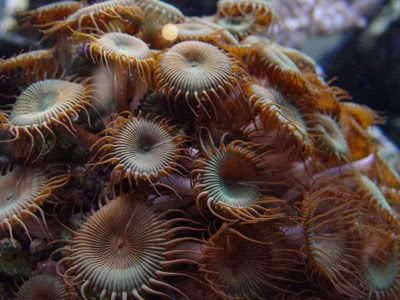
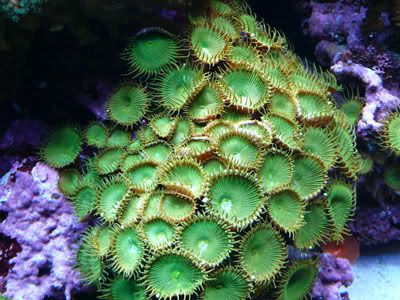
The Protopalythoa Button Polyp Corals, are also commonly referred to within the aquarium hobby as Moon Polyps, Encrusting Anemones, or Sea Mats, are generally brown or tan in color, but may also be green and fluoresce under actinic lighting. Button Polyp Corals are a colonial animal with multiple individual polyps attached to a piece of live rock or coral rubble. Over time with proper aquarium conditions Button Polyp Corals will grow out with more and more colonies being produced and over time can create a mat or carpet like appearance.
Button Polyp Corals are very easy to maintain in an established reef aquarium with only moderate water flow and lighting being required. Their polyps have the ability to sting other animals and are semi-aggressive; therefore, they need to have space between their colony and any other neighbors. Button Polyp Corals grow rapidly and will crowd out their neighbors including any sessile life; it is this rapid growth and the resulting appearance that gives them the name Sea Mats. Button Polyp Corals will reproduce easily in the reef aquarium by budding (splitting off a portion of their base or mouth), which will increase the size of their colony. For continued good health, they will also require the addition of iodine and other trace elements to the water. As with other semi-aggressive fast growing corals, be sure to place this species where it will have room to grow without coming into contact with other specimens.
Button Polyp Corals receive most of their nutrition through the symbiotic algae zooxanthellae hosted within their bodies, which provides the majority of their nutritional requirements through photosynthesis. Button Polyp Corals will also benefit from weekly feedings of micro-plankton or brine shrimp which should be fed to each individual of the colony.
Palythoa
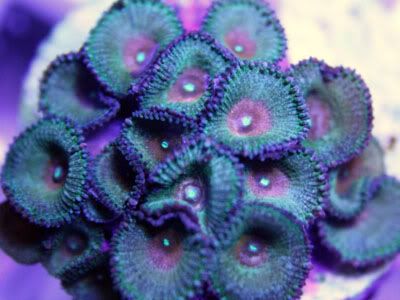
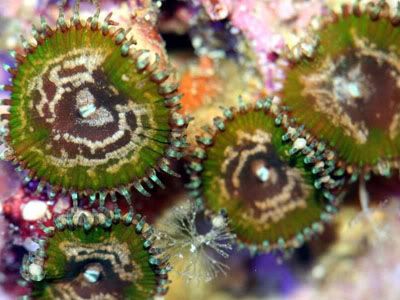
Members of this genus all look more or less the same, quite like faviid corals with which they are often confused. As mentioned previously, the coenenchyme is thickened into a cushion in which the polyps are embedded. The coenenchyme also contains sand grains. The color is usually pale yellow or brown, but fluorescent green colonies occur in some regions, and I observed some with fluorescent orange pigment in the Solomon Islands. A small colorful crab, Platypodiella, is associated with this zoanthid and apparently feeds on it, potentially obtaining a benefit from the toxin(s) the zoanthid produces (Delbeek and Sprung, 1997).
Palythoa spp are most common on reef flats or the tops of reefs, where they may form colonies several metres across. They often occur in a zone mixed with fire corals (Millepora spp.). They may also occur on reef slopes, usually as small colonies. Degraded reefs may become overgrown by them, and they are able to out-compete stony corals.
In the aquarium one should be careful not to place Palythoa where it will contact stony corals. Palythoa spp. grow best under strong illumination, and should be offered planktonic foods, such as copepods, Artemia, or Daphnia.
Zoanthus - Zoanthids, Zoas
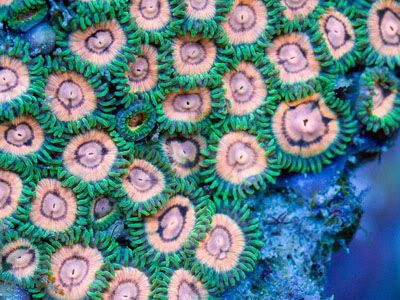
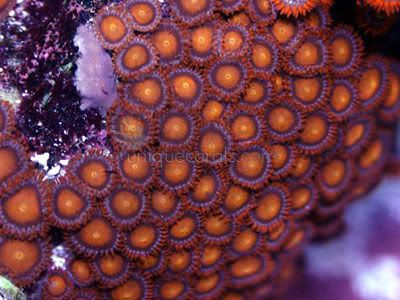
Members of this genus are the most colorful of the zoanthids, being shades of green and brown typically, but sometimes fluorescent red, orange, pink, lavender, blue, yellow, or gray, and usually two-toned. They form colonies of densely crowded polyps attached in a common tissue at the base. Some varieties form branched stolon-like creeping bases that tightly adhere to the substrate surface. One form recently imported for aquaria has polyps imbedded in a thick coenenchyme, much like Palythoa spp. Many species grow in the intertidal zone, being exposed at low tide to the baking sun, cold fronts, or to rain showers. They slowly release the water they retain in their columns in order to prevent either desiccation or damage from freshwater during a heavy rainstorm.
Zoanthus spp. do not need to be fed directly, since they obtain much of their nutritional requirements from their symbiotic zooxanthellae. They must therefore be provided with adequate illumination to thrive. They also ingest dissolved organic substances from the water, as well as fine particulate matter. Some species do not take large particles of food, while others do take and eat such things as flake food, blackworms, shrimp, and sea urchin eggs. Regular feeding promotes rapid growth.
In the Caribbean there are two species commonly known and described, Zoanthus sociatus and Z. pulchellus. In south Florida there are two additional species apparently never formally described. One of these undescribed species lives only intertidally, on rocky jetties at inlets where the ocean feeds into the intercoastal waterway. It forms continuous thick sheets of coenenchyme with the polyps imbedded, and the colors of the polyps sometimes include fantastic combinations in bright hues. This species is commonly mixed with Z. sociatus and Z. pulchellus where it occurs, and it is easily distinguished from them. The other undescribed species forms very small colonies of just a few to perhaps a few dozen polyps, usually on hardbottom reefs in sandy areas. The polyps are spaced widely and connected by a stolon. They are typically bright green, but may also be dark blue-gray or sometimes brilliant turquoise blue. The polyps are small and flattened, considerably smaller in diameter and height compared to Z. sociatus. Zoanthus sociatus forms large colonies of polyps connected at their bases by a very thin coenenchyme, so loosely connected are they that individual polyps or clumps of polyps readily break off of a colony if tugged. The coloration is variable but is generally shades of green or blue-green, often with a yellowish oral cone. Zoanthus pulchellus is found mainly on offshore coral reefs, though it can occur in inlets. It has larger polyps than Z. sociatus, and perhaps larger than any other species of Zoanthus. Zoanthus pulchellus readily accepts food while Z. sociatus does not. Zoanthus pulchellus is also more variable in coloration, being shades of green, gray, pink, or fluorescent red. Colonies of this species may cover large areas of reef substrate, particularly on back reef rubble.
The Epizoanthidae and Parazoanthidae Familes


Members of these genera are epizootic, meaning they live on other animals. Parazoanthus and Epizoanthus are almost exclusively found associated with sponges and hydroids, though they may also grow on gorgonian skeletons and even freely. They do not harbor zooxanthellae and thus must be fed zooplankton regularly in order to thrive. They occur where there are strong currents that carry plankton, so the water motion in the aquarium housing them should be swift and laminar. The association with sponges is believed to protect the sponges from predators. These zoanthid polyps are toxic and may also sting sponge eaters such as large angelfish.
For more information on the Zoanthidae Order http://www.advancedaquarist.com/issues/feb2003/invert.htm
Order: Zoanthidea (also known as Zoantharia)


Zoanthids (order Zoantharia also called Zoanthidea or Zoanthiniaria) are an order of cnidarians commonly found in coral reefs, the deep sea and many other marine environments around the world. These animals come in a variety of different colonizing formations and in numerous colors. They can be found as individual polyps, attached by a fleshy stolon or a mat that can be created from small pieces of sediment, sand and rock. The term "zoanthid" refers to all animals within this order Zoantharia, and should not be confused with "Zoanthus", which is one genus within Zoantharia.
They are among the most commonly collected coral in aquaria, easily propagating and being very durable in many water conditions.
Characteristics
Zoanthids can be distinguished from other colonial anthozoans and soft coral by their characteristic of incorporating sand and other small pieces of material into their tissue to help make their structure (except for the family Zoanthidae). The main characteristic of the order is that their tentacles are organised in two distinct rows.
While the most well-known zoanthids are the zooxanthellate genera found in tropical and sub-tropical waters (primarily Zoanthus and Palythoa), many other species and genera exist, some still relatively unknown to science. Many zoanthids (in particular the genera Epizoanthus and Parazoanthus) are often found growing on other marine invertebrates.
Often in zooxanthellate genera such as Zoanthus and Palythoa there are a large number of different morphs of the same or similar species. Such zooxanthellate genera derive a large portion of their energy requirements from symbiotic dinoflagellates of the genus Symbiodinium (zooxanthellae), similar to many corals, anemones, and some other marine invertebrates.
Hardiness
Most are considered easy. Certain varieties prove more difficult, especially blue color morphs.
Flow
Varied tolerance. Wild-caught specimens often need high flow.
Lighting
Varied tolerances. Most will grow under low light, but higher light if acclimatized will effect faster growth. Brighter varieties tend to need more light. Also, brighter varieties that are moved from intense lighting to less intense lighting have a tendency to brown out.
Placement
Varies. Zoanthids will usually grow wherever you put them. A good strategy to keep them from covering your tank in time is put them on a small rock isolated in the sand, as they will not spread over the sand.
Propagation
Easy. Under the right conditions these can grow very fast. Rule number one when fragging Zoanthus is to WEAR GLOVES and GOGGLES. The potential for poisoning from their palytoxin is high if not careful. A little "juice" on a cut, or on your fingers that you wipe your eye or mouth with, and you will feel sick. Also is easy to get squirted in the eye, hence the goggles. The best method is to use a wood chisel to scrape a small amount of rock under the attached polyps and use a razor to seperate them at their stolon. The separate pieces can then be glued to another rock or propagation plug with super glue.
Aggression
Low, but will over-grow other corals if not careful. Note potentially toxic if handled. Zoanthids can sting and significantly damage many SPS corals such as Acropora. If allowed, they can eventually sting and damage Acropora to the point where they can overgrow the base of the hard coral.
Availability
Readily available, although certain varieties can be hard to find.
Predators
Heliacus Snails
Wild zoanthid colonies are commonly collected with a predatory snail called "Heliacus." These snails specialize in eating zoanthids, and should be removed immediately.
Zoanthid-Eating Nudibranchs
Zoanthid colonies can also be afflicted by parasitic nudibranchs (sea slugs). These nudibranchs also contain the palytoxin from the zoanthids, so should be considered poisonous and handled with care.
"Fungus"
Whether or not it truly is a fungus is unclear, but certain Zoanthids, particularly pink Palythoa can get a fungus-like infection. One treatment that works well is to dip the infected colony in a solution of 80% tank water, 20% Hydrogen Peroxide for UP TO 5 minutes. This dip is strong and irritates the colony along with killing the infection, so do not dip the colony too long.
Danger
Some zoanthids contain the highly toxic substance palytoxin. Palytoxin is one of the most toxic organic substances in the world, but there is an ongoing debate over the concentration of this toxin in these animals. However, even in small quantities, the toxin can be fatal should it be ingested or enter the blood stream. If delivered immediately, vasodilators injected into the ventricle of the heart can act as an antidote.
In order for this toxin to be dangerous to humans, the average aquarist would need to ingest the zoanthid in sufficient quantities, or brush a recent cut over it. Average handling, propagation and aquarium maintenance is unlikely to pose any danger beyond a localized skin reaction.
Palytoxin is a tumor promoter, and is being studied in relation to signaling pathways in skin cancer genesis. Contrary to common belief, palytoxin can be absorbed through intact skin. The danger of acute poisoning from venomous zoanthids is quite real. An aquarist was poisoned through skin injuries on fingers by a Parazoanthus species, but recovered after 3 days. His zoanthid was found to contain 2-3 milligram of palytoxin per gram. For comparison, the intravenous LD50 dose of palytoxin for a grown man is less than 8 microgram. Thus each gram of the offending zoanthid contained enough venom to kill at least 125 grown men.
Diet
Zoanthids feed both by photosynthesis, aided by the zooxanthellae they contain, and by capturing plankton and particulate matter. Although photosynthesis aids in their nutrition, even species that do not actively capture plankton cannot live through photosynthesis alone. Zoanthids can eat meaty foods, such as lancefish, brine shrimp, krill and bloodworms.
The Zoanthidae Family
Genus:
Isaurus - Snake Polyps


Snake Polyps (Isaurus tuberculatus) are long brown polyps that attach to a hard surface like rockwork. During the day, they look like brown worms that extend from the base. At night, they extend feather-like feeding apparatus into the water to feed on zooplankton like Daphnia, Cyclopeeze, copepods and similar items. They are also photosynthetic and receive must of their nutrition from the algae in their tissues, but supplements at night will help the colony to grow and expand.
For more info on Snake Polyps see link below:
http://animal-world.com/encyclo/reef/zoanthids/IsaurusTuberculatus.php
Protopalythoa - Button Polyps, Sea Mat, Moom Polyps


The Protopalythoa Button Polyp Corals, are also commonly referred to within the aquarium hobby as Moon Polyps, Encrusting Anemones, or Sea Mats, are generally brown or tan in color, but may also be green and fluoresce under actinic lighting. Button Polyp Corals are a colonial animal with multiple individual polyps attached to a piece of live rock or coral rubble. Over time with proper aquarium conditions Button Polyp Corals will grow out with more and more colonies being produced and over time can create a mat or carpet like appearance.
Button Polyp Corals are very easy to maintain in an established reef aquarium with only moderate water flow and lighting being required. Their polyps have the ability to sting other animals and are semi-aggressive; therefore, they need to have space between their colony and any other neighbors. Button Polyp Corals grow rapidly and will crowd out their neighbors including any sessile life; it is this rapid growth and the resulting appearance that gives them the name Sea Mats. Button Polyp Corals will reproduce easily in the reef aquarium by budding (splitting off a portion of their base or mouth), which will increase the size of their colony. For continued good health, they will also require the addition of iodine and other trace elements to the water. As with other semi-aggressive fast growing corals, be sure to place this species where it will have room to grow without coming into contact with other specimens.
Button Polyp Corals receive most of their nutrition through the symbiotic algae zooxanthellae hosted within their bodies, which provides the majority of their nutritional requirements through photosynthesis. Button Polyp Corals will also benefit from weekly feedings of micro-plankton or brine shrimp which should be fed to each individual of the colony.
Palythoa


Members of this genus all look more or less the same, quite like faviid corals with which they are often confused. As mentioned previously, the coenenchyme is thickened into a cushion in which the polyps are embedded. The coenenchyme also contains sand grains. The color is usually pale yellow or brown, but fluorescent green colonies occur in some regions, and I observed some with fluorescent orange pigment in the Solomon Islands. A small colorful crab, Platypodiella, is associated with this zoanthid and apparently feeds on it, potentially obtaining a benefit from the toxin(s) the zoanthid produces (Delbeek and Sprung, 1997).
Palythoa spp are most common on reef flats or the tops of reefs, where they may form colonies several metres across. They often occur in a zone mixed with fire corals (Millepora spp.). They may also occur on reef slopes, usually as small colonies. Degraded reefs may become overgrown by them, and they are able to out-compete stony corals.
In the aquarium one should be careful not to place Palythoa where it will contact stony corals. Palythoa spp. grow best under strong illumination, and should be offered planktonic foods, such as copepods, Artemia, or Daphnia.
Zoanthus - Zoanthids, Zoas


Members of this genus are the most colorful of the zoanthids, being shades of green and brown typically, but sometimes fluorescent red, orange, pink, lavender, blue, yellow, or gray, and usually two-toned. They form colonies of densely crowded polyps attached in a common tissue at the base. Some varieties form branched stolon-like creeping bases that tightly adhere to the substrate surface. One form recently imported for aquaria has polyps imbedded in a thick coenenchyme, much like Palythoa spp. Many species grow in the intertidal zone, being exposed at low tide to the baking sun, cold fronts, or to rain showers. They slowly release the water they retain in their columns in order to prevent either desiccation or damage from freshwater during a heavy rainstorm.
Zoanthus spp. do not need to be fed directly, since they obtain much of their nutritional requirements from their symbiotic zooxanthellae. They must therefore be provided with adequate illumination to thrive. They also ingest dissolved organic substances from the water, as well as fine particulate matter. Some species do not take large particles of food, while others do take and eat such things as flake food, blackworms, shrimp, and sea urchin eggs. Regular feeding promotes rapid growth.
In the Caribbean there are two species commonly known and described, Zoanthus sociatus and Z. pulchellus. In south Florida there are two additional species apparently never formally described. One of these undescribed species lives only intertidally, on rocky jetties at inlets where the ocean feeds into the intercoastal waterway. It forms continuous thick sheets of coenenchyme with the polyps imbedded, and the colors of the polyps sometimes include fantastic combinations in bright hues. This species is commonly mixed with Z. sociatus and Z. pulchellus where it occurs, and it is easily distinguished from them. The other undescribed species forms very small colonies of just a few to perhaps a few dozen polyps, usually on hardbottom reefs in sandy areas. The polyps are spaced widely and connected by a stolon. They are typically bright green, but may also be dark blue-gray or sometimes brilliant turquoise blue. The polyps are small and flattened, considerably smaller in diameter and height compared to Z. sociatus. Zoanthus sociatus forms large colonies of polyps connected at their bases by a very thin coenenchyme, so loosely connected are they that individual polyps or clumps of polyps readily break off of a colony if tugged. The coloration is variable but is generally shades of green or blue-green, often with a yellowish oral cone. Zoanthus pulchellus is found mainly on offshore coral reefs, though it can occur in inlets. It has larger polyps than Z. sociatus, and perhaps larger than any other species of Zoanthus. Zoanthus pulchellus readily accepts food while Z. sociatus does not. Zoanthus pulchellus is also more variable in coloration, being shades of green, gray, pink, or fluorescent red. Colonies of this species may cover large areas of reef substrate, particularly on back reef rubble.
The Epizoanthidae and Parazoanthidae Familes


Members of these genera are epizootic, meaning they live on other animals. Parazoanthus and Epizoanthus are almost exclusively found associated with sponges and hydroids, though they may also grow on gorgonian skeletons and even freely. They do not harbor zooxanthellae and thus must be fed zooplankton regularly in order to thrive. They occur where there are strong currents that carry plankton, so the water motion in the aquarium housing them should be swift and laminar. The association with sponges is believed to protect the sponges from predators. These zoanthid polyps are toxic and may also sting sponge eaters such as large angelfish.
For more information on the Zoanthidae Order http://www.advancedaquarist.com/issues/feb2003/invert.htm